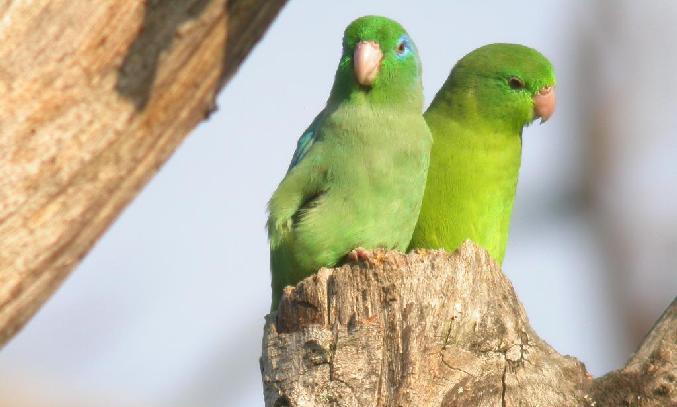Parrotlet - Spectacled
Scientific Name: Forpus conspicillatus conspicillatus
Thu, 9th January, 2025 - 2:07 am GMT
Sponsor Ads:

Alternative Name
Scientific Name: Forpus conspicillatus conspicillatusBasic Info
The Spectacled Parrotlet is brilliant green in color and has a pink beak and pink legs. Their irises are grayish brown. The birds are characterized by their periopthalmic rings, or "spectacles" which are cobalt blue in males and emerald green in females! Male Spectacled Parrotlets have undercarriages, which are a dull green. Their faces and throats are bright yellow green in color, and their breasts have a slight grayish tint. Male Spectacled Parrotlets have cobalt blue rumps; lower backs; secondary flight feathers; carpal edges; primary, secondary and under-wing coverts; and deep violet axillaries. The violet coloration is also seen at the base of the innermost primary flight feathers, which finish in green. Female Spectacled Parrotlets have no blue coloration; rather, their rumps and lower backs are emerald green. Their undersides are also a bit brighter green than those of males. Spectacled Parrotlets grow to about four and three quarters inches in length.
Health
Spectacled Parrotlets will become sick if fed a vitamin supplement in addition to a pellet diet. Many parrotlets will not eat from hooded or covered dishes. Be sure to place perches in their cages in places where they birds' tail feathers will not dip into their food or water. Breeding Spectacled Parrotlets who are breeding should be fed a calcium supplement. Those being fed a pelleted diet should be supplemented with seeds. Although only a few bloodlines were imported from Europe, Spectacled Parrotlets have proved to be prolific breeders! Immature female Spectacled Parrotlets resemble adults very closely, but males have less blue than adults. In addition, the undersides of their wings are more yellowish than adults and their periopthalmic ring is emerald green.Habitat
N/ABehavior
If you are looking for a tiny, exquisitely colored addition to your home, the Spectacled Parrotlet, a very recent addition to the parrot market, may be just the bird you have been wanting! Spectacled Parrotlets are curious, playful little animals. They are known for being less stubborn than Pacific Parrotlets, but less docile than Green-rumped Parrotlets! Truly, these birds have bright personalities, which are a happy medium in the parrotlet world. Spectacled Parrotlets should be kept alone or they can develop jealousy or aggression problems concerning everything from toys to owners- parrotlets in general do not like sharing what they consider their possessions! Be careful when taking your parrotlet outside; even Spectacled Parrotlets with clipped wings may be able to fly! Spectacled Parrotlets need lots of toys, and adore swings and rope or anything they can chew on! They are quite strong, so be sure the toys will stand up to their hard beaks. Outgoing parrotlets bond strongly with the person who spends the most time with them, especially during the time when they are between six and 12 weeks old. This does not mean, however, that older Spectacled Parrotlets will not bond with their owners; to the contrary, they make sweet pets.Origin
PanamaHistory
Spectacled Parrotlets have not been kept as pets until recently; they were just introduced into the pet market in 1992. At this time, the International Parrot Society sponsored a breeding cooperative for the Spectacled Parrotlets and they have exploded onto the aviculture scene. They are much loved by almost everyone who encounters them.Common Foods
Parrotlets should be fed a pellet diet or a basic seed mix, supplemented with plenty of fresh fruits, vegetables and of course, they need fresh water at all times. If your parrotlet is eating seeds rather than pellets, supplement their diet with vitamins.Sponsor Ads:
The point is, that geeks are not necessarily the outcasts society often believes they are. The fact is that society isn't cool enough to be included in our activities.
Parrotlet - Spectacled
Coded by: BGID® | ALL RIGHTS RESERVED Copyright © 2000-2025
Disclaimer | Privacy | Report Errors / Contact | Credits










